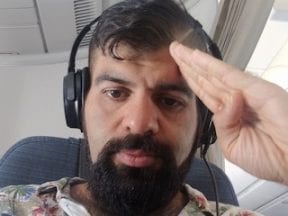In 2008 Robert Patton was coming off his second deployment in Iraq with the U.S. Army. “I was going to do 20 years in the Army,” he said, “But I’d already been on two deployments and was scheduled to go back for a third. I had a family. I didn’t want to spend half of my time in Iraq. So I had this idea.”
That idea was a unique type of men’s underwear. The first version, in 2010, failed. He rebounded. Fast forward to 2020, and his company, Sheath Underwear, is on track to record $2.6 million in annual sales.
I recently spoke with him about the idea, setbacks, and, ultimately, success. What follows is our entire audio conversation and a transcript, which has been edited for length and clarity.
Eric Bandholz: Tell us about yourself and your company.
Robert Patton: Thank you. I’m the CEO of Sheath Underwear. We launched in 2010. Sheath Underwear is different from most male underwear brands because it has a pouch on the inside to isolate the male area and keep it off your inner thighs. I came up with the idea while serving in the military in Iraq in 2008. Since 2013 we’ve been doubling annually.
Bandholz: Cool. I want to touch on what changed in 2013 to accelerate the business. Is Sheath bootstrapped or backed by venture capital?
Patton: Bootstrapped. But we did use Kickstarter. That’s where the 2013 part comes into play. We did an initial product launch in 2010. That did not go well. It set us back quite a ways because I had spent all my savings on the initial production. I could not sell the products, and it set us back three years.
But during those three years, I got out of the Army. I got a divorce and went to work for a tailor who helped me make the prototype better than the initial version. And as luck would have it, Kickstarter became a website, and we decided to give that a go in 2013. So I put up half — $5,000 — towards the second production run with the hopes that we would have a successful Kickstarter raise.
Fortunately, we did have a successful Kickstarter. I was going to sell my car if the Kickstarter process wasn’t successful.
Bandholz: Let’s talk about those early days as you’re working on the prototype. Was this a side project? Were you employed elsewhere?
Patton: I thought of the idea while in the Army in Iraq. When I returned, I bought a sewing machine and started prototyping immediately. I was still in the Army then.
I made samples for my friends, getting feedback. Everyone was intrigued.
But I was in the Army, doing well. I intended to serve 20 years. But I’d already been on two deployments to Iraq and was scheduled for a third. I had a family. I didn’t want to spend half my time in Iraq.
So I took the chance and got out. I used my GI Bill to help pay for college. I was working at that tailor, too. It got me by from 2011 to 2013.
I had that first run in 2010. I was working at the tailor, reconstructing all of those. I then sold them for a reduced price, getting more feedback.
That’s where the attitude of never quitting comes into play. I had already tattooed the brand on my back!
I had read the book “Think and Grow Rich” by Napoleon Hill. I just followed the steps of the book. Once you quit, it’s over.
Bandholz: You’ve got this side project. You’re losing money. It’s putting a strain on your marriage. What was the strategy to go to Kickstarter?
Patton: We were very bootstrap. I didn’t have any money.
As an aside, I got rear-ended by a taxi in Austin on December 31, 2012. I received an insurance check for $5,000. That was the down payment I referred to earlier.
We were looking to raise the bare minimum on Kickstarter, just enough to pay for the production. We were seeking about $8,000, and we ended up getting about $13,000.
Bandholz: So you went ahead with that production run.
Patton: Exactly. We used all of the backer’s money to buy in bulk so that we could fulfill all their orders have another 1,000 pairs to sell. We sold out relatively quickly.
Bandholz: Let’s talk a little about how you’ve been able to grow from 2013 until now.
Patton: We’ve doubled every year except last year when we grew by 30 percent. Here’s why. In 2018 we outsourced our shipping and fulfillment because our house was too small. So we outsourced to a fulfillment service. We spent roughly $20,000 a month with this company. They took advantage of us. We’ve since changed fulfillment providers.
Still, we ended up doing $1.3 million last year, even with all of those challenges. We had done $960,000 in 2018. We’re hoping for $2.6 million this year.
We’re focusing on our infrastructure, making sure our processes are streamlined and seamless so that we can get to $10 million. And reassess again.
Bandholz: Let’s discuss your marketing strategy. Influencers have been a good vehicle for you.
Patton: We go after people that have been on Joe Rogan’s show or similar. We target UFC fighters or MMA fighters. I like that stuff. So it’s fun for me to pay, like, Donald Cerrone [a fighter]. He is one of our major influencers. He’s in the UFC, has the most fights, most wins, most head kick knockouts. It’s an honor to be able to work with him. And he happens to have a huge following. It cascades from there. It didn’t start with him. It started with less-prominent fighters.
Bandholz: How can our readers find your product and connect with you?
Patton: All of our social media handles are @sheathunderwear. My personal handle is @bobbythebank — “Bobby the Bank,” like “Frank the Tank.” The website is SheathUnderwear.com.




